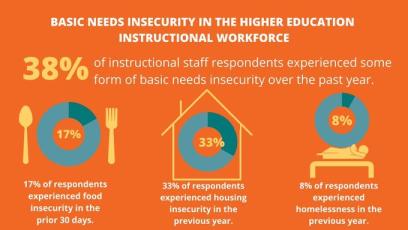A new report from the Hope Center for College, Community, and Justice has revealed a troubling reality among college and university professors: Despite the presumed prestige of the profession, many academics are underpaid and overworked, with 38 percent of instructional staff unable to meet their basic needs, including food and housing.
The Hope Center, founded by AFT member Sara Goldrick-Rab, typically studies student poverty, using the hashtag #RealCollege to debunk the myth of carefree coeds with comfortably padded spending accounts courtesy of wealthy parents, and to advocate for needed resources to help students stay in school. The center’s survey of more than 300,000 students shows that 39 percent of respondents are food insecure, 46 percent are housing insecure and 17 percent had been homeless in the previous year. (As defined by the report, homelessness includes temporarily staying with relatives or friends, or couch surfing—an inclusive definition that allows more students to receive support.)
Now the center has turned to the problem of faculty poverty. An AFT report, “An Army of Temps: AFT 2020 Adjunct Faculty Quality of Work/Life Report,” shows that nearly one in four faculty surveyed are on public assistance due to poverty, and 26 percent of adjunct faculty—people who work on temporary contracts, semester to semester—have trouble accessing enough food.
The Hope Center confirms the problem. Its survey of nearly 550 instructional staff members (from four community colleges and one university) shows 17 percent of respondents experienced food insecurity in the prior 30 days, and 33 percent experienced housing security in the previous year. Eight percent experienced homelessness.
Survey questions bring these numbers to life with wrenching clarity. Participants describe what it’s like to worry over basic necessities, answering “yes” to survey descriptions like these:
- I worried whether my food would run out before I got money to buy more.
- I cut the size of meals or skipped meals because there was not enough money for food.
- I did not pay the full amount of utilities.
- I moved in with people due to financial problems.
Other poverty signals include overwhelming student loan and credit card debt, utilization of public benefits and working multiple jobs to make ends meet.
The Hope Center also unpacks disparities by race, ethnicity and gender. Survey participants who identify as white experience food insecurity at lower rates—16 percent—than respondents who identify as Latinx (22 percent), Black (18 percent) or a member of another ethnic group, which includes Indigenous, American Indian, Alaska Native, Middle Eastern, North African, Arab, Arab American or other respondent-provided identity (41 percent).
“If you asked my friends, most would say that I do all right for myself,” wrote one participant. “But that’s not true. I think they would be shocked to know that I have to buy most of my clothing at thrift stores and that I frequent food banks on a regular basis.”
This same participant earned less than $20,000 the previous year teaching five classes over two terms; they were not offered summer classes, and during semester breaks qualified for food stamps. “Most adjunct instructors I know are dealing with those situations too,” the person wrote. “Yes, college students are struggling, and that’s truly horrible. Unfortunately, many of their instructors are, too.”
[Virginia Myers, infographic from The Hope Center]

